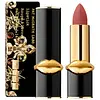What's inside
What's inside
 Key Ingredients
Key Ingredients

 Benefits
Benefits

 Concerns
Concerns

 Ingredients Side-by-side
Ingredients Side-by-side

Hydrogenated Polyisobutene
EmollientDimethicone
EmollientCetearyl Ethylhexanoate
EmollientMicrocrystalline Wax
Emulsion StabilisingCaprylic/Capric Triglyceride
MaskingPolyethylene
AbrasiveSilica
AbrasiveTrimethylolpropane Triisostearate
EmollientDimethicone/Vinyl Dimethicone Crosspolymer
Skin ConditioningKaolin
AbrasiveSynthetic Wax
AbrasiveBis-Diglyceryl Polyacyladipate-2
EmollientMica
Cosmetic ColorantCopernicia Cerifera Cera
EmollientStearalkonium Hectorite
Gel FormingPolyhydroxystearic Acid
EmulsifyingPentaerythrityl Tetra-Di-T-Butyl Hydroxyhydrocinnamate
AntioxidantPropylene Carbonate
SolventRosa Canina Fruit Oil
EmollientPassiflora Edulis Seed Acid
BleachingTocopherol
AntioxidantHydrogenated Polyisobutene, Dimethicone, Cetearyl Ethylhexanoate, Microcrystalline Wax, Caprylic/Capric Triglyceride, Polyethylene, Silica, Trimethylolpropane Triisostearate, Dimethicone/Vinyl Dimethicone Crosspolymer, Kaolin, Synthetic Wax, Bis-Diglyceryl Polyacyladipate-2, Mica, Copernicia Cerifera Cera, Stearalkonium Hectorite, Polyhydroxystearic Acid, Pentaerythrityl Tetra-Di-T-Butyl Hydroxyhydrocinnamate, Propylene Carbonate, Rosa Canina Fruit Oil, Passiflora Edulis Seed Acid, Tocopherol
Isononyl Isononanoate
EmollientAluminum Starch Octenylsuccinate
AbsorbentMica
Cosmetic ColorantPolybutene
Polyethylene
AbrasiveDicalcium Phosphate
AbrasiveParaffin
PerfumingCopernicia Cerifera Wax
Squalane
EmollientHydrogenated Soybean Oil
EmollientBis-Diglyceryl Polyacyladipate-2
EmollientPentaerythrityl Tetra-Di-T-Butyl Hydroxyhydrocinnamate
AntioxidantKaolin
AbrasivePolyhydroxystearic Acid
EmulsifyingSynthetic Wax
AbrasiveStearic Acid
CleansingMicrocrystalline Wax
Emulsion StabilisingCaprylic/Capric Triglyceride
MaskingStearalkonium Hectorite
Gel FormingPropylene Carbonate
SolventNylon-12
CI 77891
Cosmetic ColorantCI 15850
Cosmetic ColorantCI 42090
Cosmetic ColorantCI 19140
Cosmetic ColorantIron Oxides
CI 45410
Cosmetic ColorantCI 15985
Cosmetic ColorantIsononyl Isononanoate, Aluminum Starch Octenylsuccinate, Mica, Polybutene, Polyethylene, Dicalcium Phosphate, Paraffin, Copernicia Cerifera Wax, Squalane, Hydrogenated Soybean Oil, Bis-Diglyceryl Polyacyladipate-2, Pentaerythrityl Tetra-Di-T-Butyl Hydroxyhydrocinnamate, Kaolin, Polyhydroxystearic Acid, Synthetic Wax, Stearic Acid, Microcrystalline Wax, Caprylic/Capric Triglyceride, Stearalkonium Hectorite, Propylene Carbonate, Nylon-12, CI 77891, CI 15850, CI 42090, CI 19140, Iron Oxides, CI 45410, CI 15985
Ingredients Explained
These ingredients are found in both products.
Ingredients higher up in an ingredient list are typically present in a larger amount.
This ingredient is lipid-based synthetic skin-conditioning agent derived from adipic acid and a mixture of fatty acids. It is often called a lanolin substitute.
As an emollient, it helps soften and hydrate the skin. Emollients create a barrier on the skin to trap moisture in.
Due to its fatty acid base, it may not be Malassezia folliculitis safe.
Learn more about Bis-Diglyceryl Polyacyladipate-2This ingredient is an emollient, solvent, and texture enhancer. It is considered a skin-softener by helping the skin prevent moisture loss.
It helps thicken a product's formula and makes it easier to spread by dissolving clumping compounds.
Caprylic Triglyceride is made by combining glycerin with coconut oil, forming a clear liquid.
While there is an assumption Caprylic Triglyceride can clog pores due to it being derived from coconut oil, there is no research supporting this.
Learn more about Caprylic/Capric TriglycerideKaolin is a clay. It is used for oil control and to help minimize pores. Like other clays, kaolin has the ability to absorb excess sebum or oil. This can help clean out pores and mattify the skin.
Some types of kaolin may have exfoliating properties. When water is added to kaolin, it becomes a paste with small abrasive particles.
Most kaolin is a white color, but may be pink/orange/red depending on where it comes from.
The name 'kaolin' comes from a Chinese village named 'Gaoling'. Kaolin clay comes from rocks rich in kaolinite. Kaolinite, the mineral, has a silicate layered structure. Kaolinite is formed from chemical weathering of aluminum siilicate minerals.
Besides skincare, kaolin is commonly used to make glossy paper, in ceramics, toothpaste, and as medicine to soothe stomach issues.
Learn more about KaolinMica is a naturally occurring mineral used to add shimmer and color in cosmetics. It can also help improve the texture of a product or give it an opaque, white/silver color.
Serecite is the name for very fine but ragged grains of mica.
This ingredient is often coated with metal oxides like titanium dioxide. Trace amounts of heavy metals may be found in mica, but these metals are not harmful in our personal products.
Mica has been used since prehistoric times throughout the world. Ancient Egyptian, Indian, Greek, Roman, Aztec, and Chinese civilizations have used mica.
Learn more about MicaMicrocrystalline Wax is created by de-oiling petroleum. It is highly refined and purified before being added to cosmetics.
Microcrystalline Wax is used to enhance the texture and create even consistency. It helps stabilize a product by preventing ingredients from separating.
Pentaerythrityl Tetra-Di-T-Butyl Hydroxyhydrocinnamate (long name, huh?) is a synthetic antioxidant.
It is used to help stabilize other antioxidants or prevent the color from changing in a product.
As an antioxidant, it helps fight free-radical molecules. Free-radical molecules are capable of damaging our cells and other genetic material. Thus, antioxidants may reduce the signs of aging.
This ingredient is oil-soluble.
Learn more about Pentaerythrityl Tetra-Di-T-Butyl HydroxyhydrocinnamatePolyethylene is a synthetic ingredient that helps the skin retain moisture. It is a polymer.
It is also typically used within product formulations to help bind solid ingredients together and thicken oil-based ingredients. When added to balms and emulsions, it helps increase the melting point temperature.
Polyhydroxystearic Acid is a soft wax made from castor oil.
It is is a texture thickener, emulsifier, and film-former. Emulsifiers prevent ingredients from separating, such as oils and waters.
Polyhydroxystearic Acid may not be fungal acne safe.
Learn more about Polyhydroxystearic AcidThis ingredient is a solvent. It helps dissolve active ingredients and alter the texture of products.
Propylene Carbonate is commonly used in makeup and with clay, such as montmorillonite or bentonite.
Studies show this ingredient to be safe for cosmetics. When it is undiluted, it can cause skin irritation. (It is always diluted in skincare and makeup). This ingredient is water-soluble.
Propylene Carbonate is created from propylene glycol and carbonic acid.
Learn more about Propylene CarbonateStearalkonium Hectorite is a clay-derived ingredient used to thicken a product and help create a gel-like texture.
Synthetic Wax is created from fossil fuels such as natural gas. It is used to enhance texture, adjust pH, and as an occlusive.
It may also be used as an abrasive ingredient to exfoliate the skin.
Synthetic Wax may not be fungal acne safe.
Learn more about Synthetic Wax